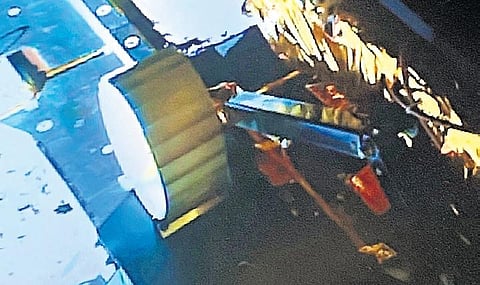

If the noise levels from all the joy and jubilation erupting at 6.04 pm on August 23, 2023 (IST) in India and around the world were to be measured in one go, it could have attained unimagined decibels.
Alongside the jubilation were awe and wonder, surprise and elation, pride and contentment, and a whole slew of feelings and expressions. The only factor that was rightly and instinctively abandoned was hate. People hugged strangers, exchanged high-fives, and danced with each other on the streets with smiles and tears of joy.
That was the moment the Chandrayaan-3 mission made a precision soft landing near the Moon’s south pole and scripted history. It became the first mission in an uncharted lunar region. The mission involves a lander and a rover. But, following the landing, it became a unifier.
Indians and those of Indian origin abroad apart, it unified the entire community of space scientists and enthusiasts across borders. They are united in anticipation and hope of new findings by Chandrayaan-3’s lander Vikram and rover Pragyaan. The two have set about their designated studies at and around the landing site near the lunar south pole. Their findings are expected to be of great value. Several space agencies are eyeing the lunar south pole for studies and experiments. They are aiming at ultimately setting up permanent bases, including NASA.
The US space agency is on a back-to-the-Moon mission with its Artemis program, planning to take four humans – including the first woman and first man of coloured race – and return them safely to Earth. They are looking at 2025-26, but before 2030.
The lunar south pole region is known to contain vast amounts of sub-surface water ice, water molecules and various minerals and elements considered useful to sustain human bases there. That is why the Moon’s south pole is coveted. That is why the world is united in the hope of Chandrayaan-3’s success in its 14-day mission.
During the live telecast on National Geographic, NASA astronaut Sunita Williams said, “I’m so looking forward to seeing the scientific research that should come out of this landing and the rover taking samples. It’s just going to be another great step in being able to have a sustainable living on the moon…!”
Canadian Chris Hadfield, former Commander of the International Space Station who flew two Space Shuttle missions, said, “It’s pivotal to history … It’s a significant step for all of us and India is right at the forefront of that…”
That is the potential of science. It unifies humankind with common objectives and aims. Days and hours ahead of the landing, people prayed in their respective places of worship, across communal boundaries created by us. They prayed for a common objective: the success of Chandrayaan-3. And their prayers were answered. They were also answered by the stupendous efforts and determination of the scientists from the Indian Space Research Organisation (ISRO), who worked tirelessly as one large unit through a raging pandemic. Their mission involved overcoming the anomalies of a preceding mission in September 2019, which failed to land as the lander crashed during the final moments of descent.
Science is neutral in every which way one sees it. The neutrality can be observed in all scientific applications to humans. If a group of astronauts belonging to different religions are put in a rocket, all of them will be subject to the same forces that are exerted on the human body during a lift-off. The forces do not act differently on different individuals based on their social, communal or political affinities.
Science unifies people at the individual, organisational, regional, national and international levels – all riding on the same hopes, aspirations and expectations. It recognises no boundaries. It is all-pervading. Its applications take no cognisance of divisions that we have created in our minds. Chandrayaan-3 has proved that as a unifier.